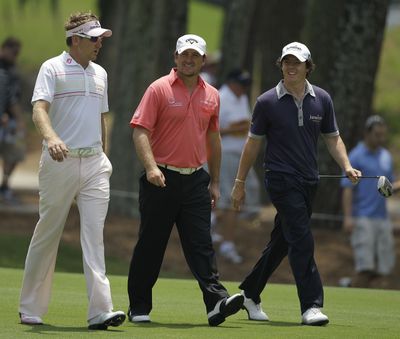PGA Tour crucial to foreign players

DALLAS — It was not just his pink pants, the upturned bill of his cap, the cool accent, or even the volcanic dust he ate as a vitamin supplement.
What really made Jesper Parnevik stand out 10 years ago was moving from his home in Sweden to Florida and attaining full membership on the PGA Tour.
These days, Parnevik would hardly stand out. Internationals have never been more in vogue.
Players from all over have relocated to the United States, transforming the PGA Tour into a global circuit. Yes, foreign is becoming the norm.
In 2000, only 17 international players finished in the top 125 on the money list. Last year there were 39.
“The PGA Tour is a global phenomenon,” said Tim Clark. “Growing up in South Africa, it’s what we watched on TV and always dreamed of coming to play.”
Consider: When the exclusive Orlando country clubs Isleworth and Lake Nona squared off in their friendly Tavistock Cup matches, 13 of the 20 players were foreigners.
Doubling up
With substantially more money, deeper fields, more World Ranking points and a higher profile, the PGA Tour has always lured internationals.
But top foreigners often spent most of their time on the European Tour, commuting to the United States for the three majors and since 1999 the three World Golf Championships.
The European Tour requires a 12-event minimum; the PGA Tour’s minimum is 15. The four majors and three WGC events count for both tours.
Some players such as Padraig Harrington, Ian Poulter, Sergio Garcia and Ernie Els are contracted to play on both sides of the Atlantic. Thus, they can be eligible for the FedEx Cup and the Race to Dubai.
“I’ve played more and more events in the U.S. over the last couple of years,” Ireland’s Harrington said. “If the FedEx Cup wasn’t there — that’s probably an extra four events — maybe I would play two of those four.”
You don’t need a GPS to realize that competing regularly against the strongest competition leads to improvement and provides a weekly gauge of development.
South Africa’s Els followed in the footsteps of golf’s original globetrotting ironman, Gary Player. Australian Greg Norman was a world-class traveler.
Their frequent-flier miles raised their profiles as well as their rankings. Els has more than 50 victories worldwide, and his global popularity spawned numerous side businesses such as course design and wine making.
Same with Norman, whose popularity sparked a major influx of Aussies to America.
“I always had intentions of playing here,” said Australian Stuart Appleby, a loyal PGA Tour member since 1996. “I didn’t feel like wasting time trying to get settled in Europe. This was where I wanted to be.”
The European Tour has been sensitive to losing marquee names.
But it cannot offer nearly the prize money of the PGA Tour, bolstered by Tiger Woods-leveraged TV contracts. The FedEx Cup pays top-10 bonuses ranging from $500,000 to $10 million for the season champion.
Most significant, foreigners improve their shot at glory in the Masters, U.S. Open and PGA Championship by playing on U.S. style courses.
Harrington was a world-class player but was considered one of the best to never win a major until he began competing regularly on the PGA Tour. He has won three of the last nine majors.
Asked what playing full time in the States has done for him, Harrington said, smiling, “I don’t think we have enough time.”
Poulter’s jump into the top six of the World Ranking coincided with his first victory in the United States, the WGC Match Play in February.
He confined himself to the European Tour the first five years of his career, 2000-04. He qualified for only nine majors, finishing in the top 25 once. As a full-time PGA Tour member since 2005, he has nine top-20s in 20 majors, including two seconds.
There is also the Tiger Woods factor. International players who grew up idolizing Woods know they can’t beat the best if they don’t play the best.
Northern Ireland’s Rory McIlroy, a teenage winner in the first of two seasons on the European Tour, had only one place to go after jumping to No. 16 in the World Ranking.
“I just feel that I will become a better golfer if I also play in America,” McIlroy explained when announcing his decision last August.
Two days shy of his 21st birthday, McIlroy broke through for victory at the Quail Hollow Championship last month.
Expanding the game
As the United States attracts foreigners to its shores, the growth of golf continues its march to distant lands. Course designers are leaving the United States to mine gold in China.
The success of international players has sparked worldwide interest.
South Korea’s Y.E. Yang, based in Southlake, brought Asia its first men’s major title with his 2009 PGA Championship victory over Woods.
Argentine Angel Cabrera is the first South American to win two majors.
Camilo Villegas, one of the world’s best young players, has popularized the game in Colombia.
The rest of the world, having improved by coming to the United States, is catching up.
The last decade has seen a dramatic shift in power.
Americans occupied 57 of the top 100 spots in the Official World Golf Ranking of 2000. Ten years later, only 31 Americans finished in the top 100.
Since 2005, international players have won nine of 21 majors.
The golf world might be much different had Parnevik never left the European Tour and settled in Orlando.